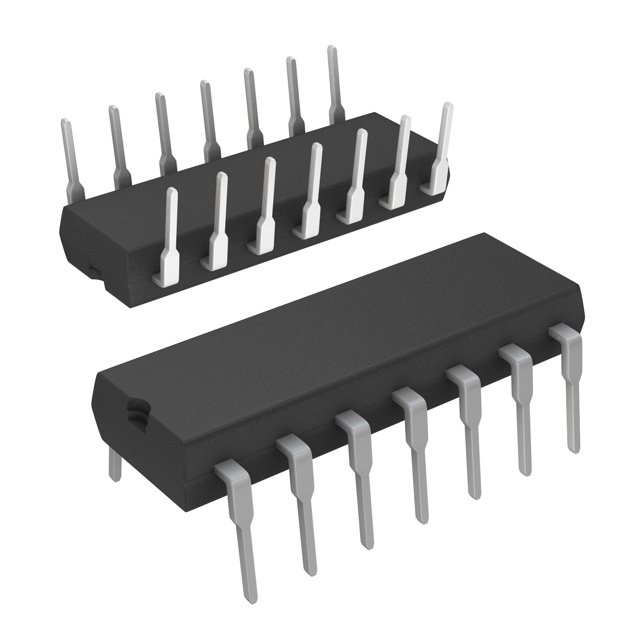MCP42010-I/P
Product Overview
Category
The MCP42010-I/P belongs to the category of digital potentiometers.
Use
It is primarily used for digitally controlling resistance in electronic circuits.
Characteristics
- Digital control of resistance
- Compact package size
- High resolution and accuracy
- Low power consumption
Package
The MCP42010-I/P is available in a 14-pin plastic dual inline package (DIP).
Essence
The essence of the MCP42010-I/P lies in its ability to replace traditional mechanical potentiometers with a digital alternative, providing precise and programmable resistance control.
Packaging/Quantity
This product is typically packaged in reels or tubes, with quantities varying based on customer requirements.
Specifications
- Resolution: 8 bits
- Number of Channels: 2
- Resistance Range: 0 to 10 kΩ
- Interface: SPI (Serial Peripheral Interface)
- Supply Voltage: 2.7V to 5.5V
- Operating Temperature Range: -40°C to +125°C
Detailed Pin Configuration
- VDD - Power supply voltage
- CS - Chip select input
- SCK - Serial clock input
- SDI - Serial data input
- SDO - Serial data output
- VSS - Ground
- A - Terminal A of channel 0
- W - Wiper terminal of channel 0
- B - Terminal B of channel 0
- H - Terminal A of channel 1
- X - Wiper terminal of channel 1
- L - Terminal B of channel 1
- NC - No connection
- VREF - Reference voltage input
Functional Features
- Non-volatile memory for storing wiper position
- Increment/decrement control for resistance adjustment
- Software programmable resistance values
- Low temperature coefficient for stable performance
Advantages and Disadvantages
Advantages
- Precise and accurate resistance control
- Compact size saves board space
- Eliminates mechanical wear and tear
- Easy integration into digital systems
- Non-volatile memory retains settings during power-off
Disadvantages
- Limited resolution compared to some analog potentiometers
- Higher cost compared to traditional potentiometers
- Requires digital interface for control
Working Principles
The MCP42010-I/P utilizes a combination of digital-to-analog conversion and resistive ladder networks to achieve precise resistance control. The digital inputs are converted into corresponding resistance values, allowing the user to adjust the wiper position digitally.
Detailed Application Field Plans
The MCP42010-I/P finds applications in various fields, including:
- Audio Equipment: Volume control, tone adjustment
- Instrumentation: Calibration, signal conditioning
- Industrial Control Systems: Process control, automation
- Communication Systems: Signal attenuation, impedance matching
- Test and Measurement: Programmable resistance loads, calibration
Detailed and Complete Alternative Models
- MCP41010-I/P: Single-channel digital potentiometer with similar specifications
- MCP42050-I/P: Dual-channel digital potentiometer with higher resolution
- MCP42510-I/P: Quad-channel digital potentiometer for multi-channel applications
These alternative models offer different features and specifications to cater to specific application requirements.
In conclusion, the MCP42010-I/P is a digital potentiometer that provides precise resistance control in electronic circuits. Its compact size, high resolution, and non-volatile memory make it suitable for various applications in audio equipment, instrumentation, industrial control systems, communication systems, and test and measurement. While it has advantages such as accuracy and ease of integration, it also has limitations in terms of resolution and cost. However, alternative models are available to address specific needs.
Lista 10 Vanliga frågor och svar relaterade till tillämpningen av MCP42010-I/P i tekniska lösningar
What is the MCP42010-I/P?
The MCP42010-I/P is a digital potentiometer that can be used to digitally control resistance in various electronic circuits.What is the maximum resistance value of the MCP42010-I/P?
The MCP42010-I/P has a maximum resistance value of 100 kΩ.Can the MCP42010-I/P be used in audio applications?
Yes, the MCP42010-I/P can be used in audio applications for volume control and tone adjustment.What is the supply voltage range for the MCP42010-I/P?
The supply voltage range for the MCP42010-I/P is typically between 2.7V and 5.5V.Is the MCP42010-I/P compatible with SPI communication?
Yes, the MCP42010-I/P uses SPI communication for digital control.Can the MCP42010-I/P be used in industrial automation systems?
Yes, the MCP42010-I/P can be used in industrial automation systems for precise resistance control.What is the temperature range for the MCP42010-I/P?
The MCP42010-I/P has an operating temperature range of -40°C to 125°C.Does the MCP42010-I/P have non-volatile memory?
Yes, the MCP42010-I/P has non-volatile memory, allowing it to retain its settings even when power is removed.Can multiple MCP42010-I/P devices be daisy-chained together?
Yes, multiple MCP42010-I/P devices can be daisy-chained together for simultaneous control.What are some typical applications for the MCP42010-I/P?
Typical applications for the MCP42010-I/P include instrumentation, sensor calibration, programmable gain amplifiers, and offset adjustment in analog circuits.


